Often people tell me there is no point in protests. They never change things. And of course they are wrong, although of course they don’t always succeed, even when they enjoy massive backing – as our involvement in the Iraq invasion and yesterday’s vote to bomb Syria show.
Two of the protests I covered in the last few days of July have since then resulted in at least a part successful resolution, achieving outcomes that certainly would not have happened without the protest. Both of them were protests about workplace issues, and both involved the unfair dismissal of people for normal trade union activities, and as well as opposing victimisation the protests also resulted in at least some progress on the issues over which they had been taking action. I don’t know the fine detail of the settlements reached, but I do know in both cases protest – and in the case of the PCS at the National Gallery, 100 days of strike – achieved gains which would otherwise not have happened.
The third protest was about Palestine, and in particular about the failure of the BBC to report with the even-handedness it proclaims. Here there has been perhaps little progress, although more has come out – even from within the organisation – confirming its pro-Israel bias, and I think there has been a slight shift, with more attention being paid to the work of some of the BBC’s correspondents in Israel and Palestine rather than the prejudices of those in the studios and back rooms.
The strength of the BBC has always been in the reports of its foreign correspondents, who include some of the best journalists around. Its often at its best in the World Service rather than here in Britain. I remain a firm supporter of the BBC in spite of realising that we have to go elsewhere in search of what is happening in the UK and sensible unbiased opinion on politics in this country. It’s a real shame that it can’t reflect a more independent view here – and particularly in Westminster rather than so often following the promptings of our billionaire-directed press.
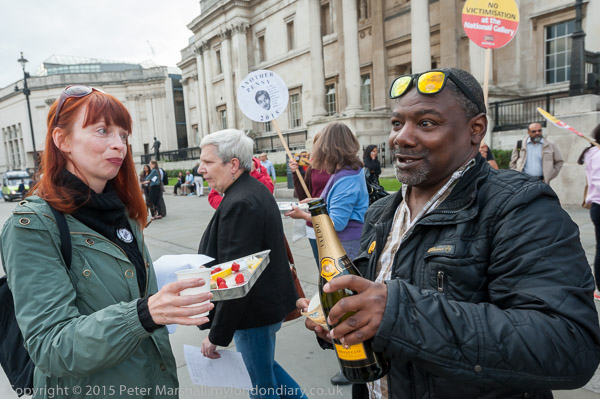
First up was a protest by National Gallery staff outside the leaving party for director Nicholas Penny in Trafalgar Square. I was shocked to find that many of the gallery staff had not even been invited, and they held their own little party outside, against the plans for privatisation and de-skilling that the departing director had signed off, despite giving his opinion that he didn’t feel they were appropriate.
The plans are all a part of the current government’s policy to sell off everything. Partly its a matter of reducing government debts, partly of putting fat profits into the hands of their mates (and themselves) in the private sector. Outsourcing cuts costs by employing less skilled staff on lower wages and inferior conditions and the only thing it ever improves is the bank balances of the out-sourcing company’s shareholders.
Photographically the only problem was in making something of fairly meagre subject matter. The light was fine, there were no problems of access, people were mainly happy to be photographed (though a few a little camera-shy) and there were few other photographers present.
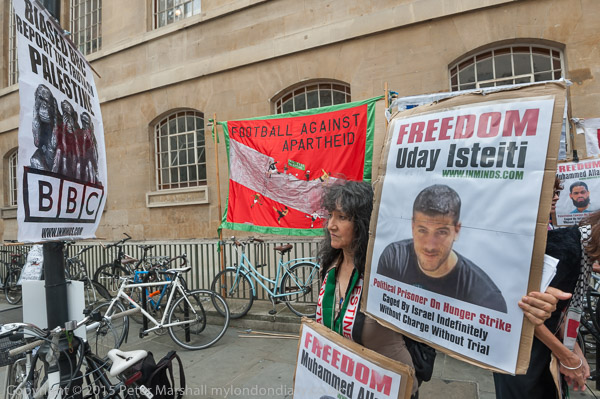
The following day at the BBC there were more posters and banners, but I arrived rather late, and was short of time before the protesters left – and some had done so already.
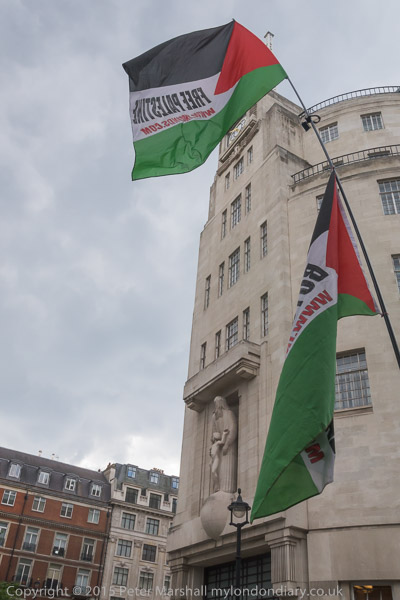
Although the old Broadcasting House is an iconic building and protesters can protest close to it, the entrance to the newer block which identifies it as the BBC is set well back in a private yard, which security keep protesters – or at least organised protests such as this – outside. It’s a little hard to really visually link the protesters with the BBC. And although I recognise the frontage of Broadcasting House, I’m not sure how many will.
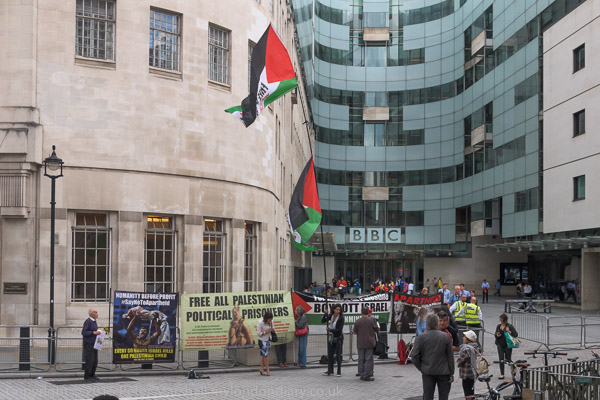
Even using a fairly long lens to compress distances, it’s hard to really link the protesters with their banners on the fence in front to that BBC above the entrance.
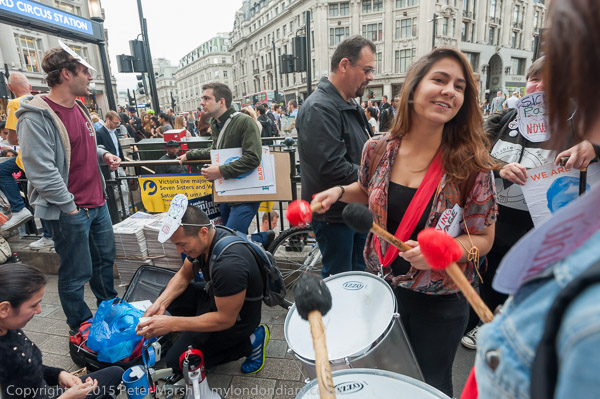
From Broadcasting House it is only a short walk to Oxford Circus where United Voices of the World were meeting to march to Sotheby’s for the start of the protest over the ‘Sotheby’s 2′, Percy and Barbara, sacked for taking part in a protest outside their workplace for better conditions of employment – sick pay, holidays and pensions.
Previous protests had already let to the reinstatement of two sacked workers, and the last one a couple of weeks earlier had been met by a large and heavy-handed police response, trying to restrict the movement of the protest around the streets. This time their were few police and they simply stood in a line along the pavement in front of the doorway.
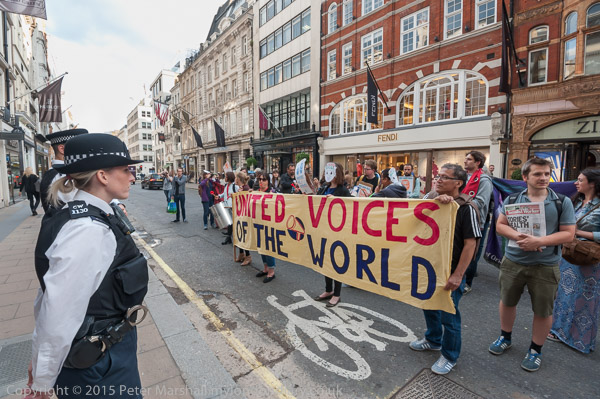
It was curiously low-keyed, but perhaps showed that some officers at least had learnt from the previous occasion, and this protest cause much less disruption of the area than the previous one. These are protesters who are prepared to make a lot of noise to make sure their protest is noticed, but not people out to cause any serious damage. But none of us likes being pushed around by police, and tempers sometimes flare on both sides if officers try aggressive tactics.

‘Protest‘, as one of the banners stated, ‘Is A right‘, and the police often claim that they facilitate it, though at times they seem more concerned with its restriction. But on this occasion things went smoothly. It wasn’t boring to photograph, though there were none of the scenes which are likely to make it news in the eyes of the media.
And that’s perhaps something of a dilemma for photographers who cover protests. We know that protests without violence are unlikely to make the news and that our chances of having pictures bought are relatively low. I happen to think that the victimisation of low-waged workers by a prestigious high-profile employer like Sotheby’s who are making huge profits merits a place in the news. It is a scandal that should not happen in a civilised society.
But the wealthy owners and well-paid editors who control our news regard it as without interest – unless perhaps a ‘celebrity’ takes part or they can condemn those who lack power in our society.
It took another protest or two, but in the end Sotheby’s and the UVW came to some kind of agreement, though I don’t know the details. But here as in a number of other cases, they have managed to protect members and improve conditions by action.
______________________________________________________
My London Diary : Buildings of London : River Lea/Lee Valley : London’s Industrial Heritage
All photographs on this and my other sites, unless otherwise stated, are taken by and copyright of Peter Marshall, and are available for reproduction or can be bought as prints.
To order prints or reproduce images
________________________________________________________